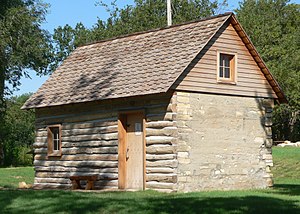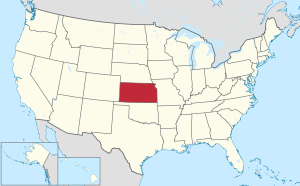Smith County (standard abbreviation: SM) is a county in the U.S. state of Kansas. In 2020, 3,570 people lived there.[1] Its county seat is Smith Center.[2] The county is named after Maj. J. Nelson Smith, who was part of the 2nd Colorado Cavalry. He was killed in action at the Battle of Westport on October 21, 1864.
Smith County | |
|---|---|
 Home on the Range Cabin near Smith Center (2014) | |
 Location within the U.S. state of Kansas | |
 Kansas's location within the U.S. | |
| Coordinates: 39°50′N 98°45′W / 39.833°N 98.750°W | |
| Country | |
| State | |
| Founded | 1872 |
| Named for | J. Nelson Smith |
| Seat | Smith Center |
| Largest city | Smith Center |
| Area | |
| • Total | 897 sq mi (2,320 km2) |
| • Land | 895 sq mi (2,320 km2) |
| • Water | 1.5 sq mi (4 km2) 0.2% |
| Population | |
| • Total | 3,570 |
| • Density | 4.0/sq mi (1.5/km2) |
| Time zone | UTC−6 (Central) |
| • Summer (DST) | UTC−5 (CDT) |
| Area code | 785 |
| Congressional district | 1st |
| Website | ks1495 |
The geographic center of the contiguous United States is in the county, near Lebanon.[3]
History
change19th century
changeIn 1872, Smith County was created. The first homestead in Smith County was in 1871. There were 3,800 people living there by 1875. The county grew to 15,000 people by 1889. Corn was the main crop, but drought and grasshoppers hurt the crops. When hardy Winter wheat was introduced to Kansas by Russian settlers, it eventually became the main crop in Smith County. The number of people living in Smith County has slowly gone down since 1900. This is due to advanced farming techniques that need fewer people to farm.[source?]
Brewster Higley wrote the song "Home on the Range" in 1873 in a cabin 9 miles northwest of Smith Center. It later became the Kansas State song.[4][5]
Geography
changeThe U.S. Census Bureau says that the county has a total area of 897 square miles (2,320 km2). Of that, 895 square miles (2,320 km2) is land and 1.5 square miles (3.9 km2) (0.2%) is water.[6] The county is divided into 25 townships, each of which is listed below in the subdivisions section of this article.
The geographic center of the 48 contiguous states is in the county, near the city of Lebanon.[7] The geographic center of North America is located in neighboring Osborne County.
The Solomon River runs through the southern part of the county. It provides a flat basin and water for irrigation.
Major highways
changeThere are two major highways in the county. The main east–west route is U.S. Highway 36. It goes through Athol, Kensington, and Smith Center. The main north–south route is U.S. Highway 281. Kansas state highways K-8, K-9 and K-180 go to other areas of the county.
People
change| Historical population | |||
|---|---|---|---|
| Census | Pop. | %± | |
| 1870 | 66 | — | |
| 1880 | 13,883 | 20,934.8% | |
| 1890 | 15,613 | 12.5% | |
| 1900 | 16,384 | 4.9% | |
| 1910 | 15,365 | −6.2% | |
| 1920 | 14,985 | −2.5% | |
| 1930 | 13,545 | −9.6% | |
| 1940 | 10,582 | −21.9% | |
| 1950 | 8,846 | −16.4% | |
| 1960 | 7,776 | −12.1% | |
| 1970 | 6,757 | −13.1% | |
| 1980 | 5,947 | −12.0% | |
| 1990 | 5,078 | −14.6% | |
| 2000 | 4,536 | −10.7% | |
| 2010 | 3,853 | −15.1% | |
| 2020 | 3,570 | −7.3% | |
| U.S. Decennial Census[8] 1790-1960[9] 1900-1990[10] 1990-2000[11] 2010-2020[1] | |||
Government
changePresidential elections
change| Year | Republican | Democratic | Third Parties |
|---|---|---|---|
| 2020 | 82.8% 1,763 | 15.8% 336 | 1.4% 30 |
| 2016 | 81.3% 1,661 | 14.5% 297 | 4.1% 84 |
| 2012 | 80.3% 1,624 | 17.7% 358 | 2.0% 41 |
| 2008 | 77.8% 1,719 | 20.2% 446 | 2.0% 45 |
| 2004 | 76.1% 1,803 | 22.8% 540 | 1.1% 27 |
| 2000 | 70.2% 1,534 | 24.5% 534 | 5.3% 116 |
| 1996 | 65.4% 1,628 | 25.6% 638 | 9.0% 224 |
| 1992 | 43.3% 1,236 | 27.7% 789 | 29.0% 827 |
| 1988 | 65.3% 1,951 | 33.6% 1,004 | 1.1% 33 |
| 1984 | 75.7% 2,332 | 22.2% 684 | 2.1% 63 |
| 1980 | 71.7% 2,415 | 21.4% 719 | 6.9% 234 |
| 1976 | 58.5% 2,009 | 38.8% 1,333 | 2.7% 94 |
| 1972 | 74.3% 2,600 | 23.4% 818 | 2.4% 83 |
| 1968 | 67.5% 2,558 | 24.8% 939 | 7.7% 293 |
| 1964 | 52.3% 2,026 | 46.7% 1,809 | 0.9% 36 |
| 1960 | 71.9% 3,013 | 27.6% 1,157 | 0.5% 22 |
| 1956 | 73.0% 3,142 | 26.5% 1,139 | 0.6% 26 |
| 1952 | 77.8% 3,623 | 21.2% 986 | 1.1% 51 |
| 1948 | 61.9% 2,760 | 35.7% 1,590 | 2.4% 106 |
| 1944 | 69.9% 3,282 | 29.3% 1,377 | 0.7% 34 |
| 1940 | 65.6% 3,630 | 33.5% 1,855 | 0.9% 50 |
| 1936 | 53.5% 3,292 | 46.3% 2,847 | 0.3% 17 |
| 1932 | 46.5% 2,870 | 51.1% 3,155 | 2.3% 144 |
| 1928 | 74.3% 4,021 | 24.7% 1,338 | 0.9% 50 |
| 1924 | 57.2% 3,226 | 29.0% 1,634 | 13.8% 777 |
| 1920 | 66.1% 3,251 | 31.2% 1,535 | 2.7% 132 |
| 1916 | 41.1% 2,605 | 54.1% 3,431 | 4.8% 306 |
| 1912 | 25.8% 970 | 40.9% 1,534 | 33.3% 1,250 |
| 1908 | 51.7% 1,843 | 44.7% 1,593 | 3.7% 132 |
| 1904 | 66.0% 2,254 | 17.5% 596 | 16.5% 564 |
| 1900 | 46.5% 1,770 | 51.9% 1,978 | 1.6% 61 |
| 1896 | 40.2% 1,385 | 58.6% 2,019 | 1.1% 39 |
| 1892 | 41.3% 1,389 | 58.7% 1,972 | |
| 1888 | 51.7% 1,726 | 23.3% 777 | 25.0% 835 |
Smith County is very Republican. No Democratic presidential candidate has won Smith County since Franklin D. Roosevelt in 1932. Since 1940, the only Democrat to win forty percent of the county’s vote was Lyndon Johnson in 1964.
Education
changeUnified school districts
change- Thunder Ridge USD 110
- Kensington, Athol and western third of county; school district also covers the eastern third of Phillips County
- Smith Center USD 237
- Smith Center, Lebanon, Gaylord and eastern two-thirds of county
Communities
changeCities
changeReferences
change- ↑ 1.0 1.1 1.2 "QuickFacts: Smith County, Kansas". United States Census Bureau. Retrieved October 3, 2023.
- ↑ "Find a County". National Association of Counties. Retrieved 2011-06-07.
- ↑ "Population and Geographic Centers" (PDF). www.census.gov. Retrieved March 6, 2014.
- ↑ Kansas Historical Society (October 2015). "Smith County, Kansas". Kansapedia. Retrieved 21 May 2019.
- ↑ Kansas Historical Society (December 2014). "Brewster Higley". Kansapedia. Retrieved 21 May 2019.
- ↑ "US Gazetteer files: 2010, 2000, and 1990". United States Census Bureau. 2011-02-12. Retrieved 2011-04-23.
- ↑ "Geographic Center of the Lower 48 United States". Archived from the original on 2012-02-04. Retrieved 2019-07-31.
- ↑ "U.S. Decennial Census". United States Census Bureau. Retrieved July 29, 2014.
- ↑ "Historical Census Browser". University of Virginia Library. Archived from the original on August 11, 2012. Retrieved July 29, 2014.
- ↑ "Population of Counties by Decennial Census: 1900 to 1990". United States Census Bureau. Retrieved July 29, 2014.
- ↑ "Census 2000 PHC-T-4. Ranking Tables for Counties: 1990 and 2000" (PDF). United States Census Bureau. Retrieved July 29, 2014.
- ↑ "Dave Leip's Atlas of U.S. Presidential Elections".
More reading
change- Standard Atlas of Smith County, Kansas; Geo. A. Ogle & Co; 82 pages; 1917.
- Plat Book of Smith County, Kansas; North West Publishing Co; 48 pages; 1900.
Other websites
change- County
- Other
- Maps